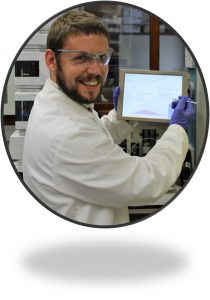Quick screening of reaction partners is clearly very important for discovery, and one of the things I’ve been working on a lot lately is automated library synthesis. I think this is one of the major advantages to being able to use a flow protocol; a great many of the things we do as chemists are straightforward, repetitive and time-consuming. Any technology that frees us from the laborious tasks and makes us available to work on complex challenges simply has to be an improvement.
We’re able to use a range of different liquid-handlers, and we recently took delivery of a small handler that fits just nicely in my fume hood. I use it with pretty much everything now, sometimes to load reagents, but often just as a collector, allowing me to schedule a list of reactions in the morning and leave it running through the day while I work on other things. I’ve needed to run various analyses on the library compounds, so have gone up to 5 ml loading loops, which at the concentrations I’ve been using give me plenty of material to isolate and analyse in whatever way is needed. There have been a few challenges along the way; one photochemical library has been producing cyclobutyl adducts from a range of maleimide and uracil derivatives, added via a [2+2] to ethene. The problem is that ethene gas has variable solubility in the different reagent solutions, sometimes most of it dissolves into the liquid, reducing the flow velocity and increasing residence time, then a different substrate is added by the handler and the ethene now doesn’t dissolve, increases flow velocity and pushes everything out of the reactor faster. A bit of a worry when you’re collecting your product automatically.
The solution was quite straightforward for me, I put a UV detector inline and made my collection window larger than it needed to be – I wasn’t carrying out an optimisation so only collecting the steady state wasn’t as important. A more elegant way to work would have been to use the UV to start the collection when it detected the material, I’ll have to do that next time. Either way, the liquid-handler has liberated me from the fume-hood for most of the day, which has enabled me to be more involved with applications support and product development, all the while keeping the output of the lab the same. Of course, when you find something interesting, you’re always going to want more of it but then that’s the advantage of a flow protocol at the lab scale; just run longer.
Ideal.


